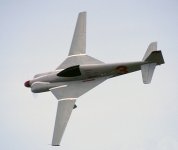fuse lift
Yeah, it really doesn't seem that the fuselage should count as wing area since it by itself would have to be at maybe 30 degrees to generate much lift.
But when there is a wing on each side, the fuselage gets very enthusiastic about lifting, sometimes overdoing it.
Ideally, the fuse lift should be designed to lift exactly the same as a wing extended through its position would. That will give the highest span efficiency.
In fact, if the fuse did not lift, there would be a drastic hole in the middle of the span lift distribution and the induced drag would be sky high with the plane still on the ground trying to lift off.
An example of this, amusing to recall, is a Breezy type photo plane that was designed to to do some Hollywood stuff at Flabob airport years ago. The 2 j3 wing panels were connected with a 3 foot gap in the middle. It would not fly. When a wing center section, as I had originally suggested was added to replace the missing fuselage, it flew like a bird, a drafty, slow one that did its job well.
So, yes, fuselages do their share of lifting as part of the wing system and including the projected area is perfectly justified.
Ron





